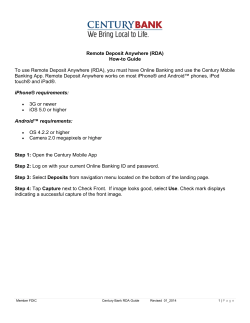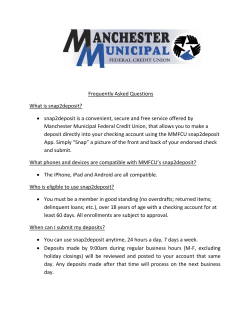
- Paul Hastings
December 2014 Follow @Paul_Hastings Dealing with the FDIC Final Rule on DuallyPayable Deposits BY V. GERARD COMIZIO & RYAN CHIACHIERE I. Introduction In February 2013, in response to a paper issued by the United Kingdom’s Financial Services Authority (“U.K. FSA”) described below, the FDIC issued a notice of proposed rulemaking in which it proposed a new regulation to explicitly state that deposits payable in branches of U.S. insured depository 1 institutions outside the U.S. are not FDIC-insured. On September 13, 2013, the FDIC adopted the final rule (“Final Rule”), clarifying that deposits in foreign branches of U.S. banks are not FDIC insured 2 though they may be deposits for purposes of the depositor preference regime. The Final Rule applies to deposits even if they are considered “dually payable,” or payable in both the 3 U.S. and the foreign country. Under the Final Rule, foreign deposits are still considered deposit liabilities even though they are not insured, and are on equal footing with domestic deposits under the 4 depositor preference regime of the Federal Deposit Insurance Act. Accordingly, these deposits receive preferred status over general unsecured creditors in the event of a bank failure and FDIC 5 receivership. The FDIC has asserted that the Final Rule is not intended to stop U.S. banks from drafting deposit agreements in such a way as to protect themselves from sovereign risk liability, or taking advantage of relevant federal and state law, as well as judicial precedent on this issue. It is, however, designed to ensure that the FDIC does not take on the role of a worldwide insurer of 6 deposits, and thus, impacts deposit agreement with foreign branches of U.S. banks. As the Final Rule is now being administered and enforced by the FDIC, it is important to understand the regulatory 7 impact of these rules structuring foreign branch deposit operations. For a more comprehensive analysis of applicable federal and state statutes and regulations and judicial precedent related to the payment of foreign branch deposits in the United States, see V. Gerard Comizio and Ryan Chiachiere, ‘Ringfencing’ U.S. Bank Foreign Branch Deposits: Working Toward a Clearer Understanding of Where Deposits are Payable in the Midst of Chaos, 2014 Am. U. Bus. L. Rev 249 (2014). II. Background The notice of proposed rulemaking came in response to a Consultation paper issued by the U.K. FSA. This proposed to prohibit banks that are not based in the European Economic Area (“EEA”) from operating deposit-taking branches in the U.K. unless U.K. depositors are put on an equal footing in the depositor preference regime with depositors from the bank’s home country in the event of a 8 resolution. The U.K. FSA offered several options for the non-EEA banks that wish to continue deposit- 1 taking: (1) use a U.K.-incorporated subsidiary instead of a branch, so that U.K. resolution and insolvency laws apply and U.K. depositors are not subordinated to home-country depositors; (2) segregate assets in the U.K. through a trust arrangement and provide a legal opinion explaining how the arrangement prevents subordination of U.K. depositors; (3) make the deposits dually payable, such that under U.S. law, U.K. deposits would occupy the same priority as uninsured home 9 country deposits. The FDIC, predicting that most U.S. banks would prefer the third option offered by the U.K. FSA, sought through this rulemaking to protect the Deposit Insurance Fund (“DIF”) by clarifying that a foreign branch deposit, though it may be dually payable and on the same footing as a domestic 10 deposit in terms of the depositor preference regime, is not insured by the DIF. The FDIC believed that the Final Rule would preserve confidence in the DIF by protecting it against the possibility of 11 becoming a global deposit insurer. III. Industry Comment The comment period ended on April 22, 2013, and the FDIC received comments from only three 12 industry groups and two individuals. Commenters generally did not object to the concept that the DIF should not insure deposits in foreign branches, but suggested an alternative approach whereby the FDIC interpret “deposit liability” to include all deposits of a U.S. bank no matter where payable for the purposes of the depositor preference regime in Section 11(d)(11) of the Federal Deposit Insurance 13 Such an approach, commenters argued, would “bolster[] international cooperation” and Act. “eliminate[] the potential for inconsistent treatment of deposits in different foreign jurisdictions,” in addition to saving the FDIC the expense of continued efforts at guidance to banks, foreign depositors, 14 and foreign regulators regarding dual payability. The FDIC rejected this approach as “inconsistent with current statutory language,” and did so explicitly “[w]ithout expressing an opinion as to the 15 merits” of the policy arguments commenters made in support of their approach. Accordingly, the Final Rule was ultimately adopted as proposed, with minor changes that did not impact the substance 16 of the proposal. One thing is certain, the FDIC, in its primary role as the U.S. deposit insurer, wants to make very clear that it is not responsible for U.S. banks’ foreign branch deposits. IV. Drafting Language in Deposit Agreements U.S. banks may use deposit agreements to create various covenants and clauses restricting payment 17 on deposits to the foreign issuing branch. A bank’s risk can be potentially mitigated via the language in deposit agreements. Nonetheless, while the explicit terms of the agreement and the reasonable expectations of the parties ought to be the “fundamental issue” in determining whether a bank is 18 required to pay on a deposit that is exposed to political risk, some courts have been reluctant to side against depositors in the perceived absence of precise language in the deposit agreement addressing 19 the issue. Further, while various federal and state laws provide banks protection from foreign deposit liability under a number of circumstances, these laws alone are not an impenetrable shield against such liability. For example, 12 USC § 633 generally provides that no foreign deposit obligations inure to the home office “if the branch cannot repay due to war, insurrection, civil strife, or an action by a foreign government or instrumentality”—de jure or de facto—in the country in which the branch is located. 20 These limitations on liability, however, may factually turn on whether the branch is closed in anticipation of such events as opposed to the prescribed circumstances causing the closure of the branch. In the former scenario, some courts have tended to view such closures as “voluntary”—even in the face of imminent threats—and thus, subject to a “springing situs” theory of deposit liability back 2 to the house office, 21 while the statutes, by their terms, arguably contemplate that the existence of any of the circumstances prescribed may be enough to relieve the bank of home office liability. 22 V. Action Plan This Final Rule is currently in effect. Banks should create an action plan to address issues with the potential impact from implementation of the Final Rule. Banks should review deposit agreements. Banks should carefully and narrowly draft deposit agreements with depositors in foreign branches, such that there can be no confusion as to whether the home branch is liable for foreign deposits. This includes not only explicit provisions addressing where deposits are payable, but also explicit provisions specifying where deposits are not payable. Courts have tended not to limit home office liability of banks that have accepted foreign branch deposits unless they accepted such deposits only under the most rigorous and express deposit 23 agreement provisions regarding allocation of risk. Corporate and sovereign depositors should review deposit agreements. Corporate and sovereign depositors should keep in mind that absent explicit language in a deposit agreement to the contrary, there is still the possibility of allocating political risk to the bank seeking to specify such allocation in the deposit agreement, or relying on limitations provided under federal or state laws such as 12 USC § 633. Paul Hastings attorneys are actively working with bank-side and depositor-side clients to identify and address the impact of the Final Rule on their operations and to review relevant federal and state law regarding performance limitations on foreign deposits. If you have any questions concerning these developing issues, please do not hesitate to contact any of the following Paul Hastings Washington, D.C. lawyers: V. Gerard Comizio 1.202.551.1272 vgerardcomizio@paulhastings.com Ryan A. Chiachiere 1.202.551.1767 ryanchiachiere@paulhastings.com 1 See FDIC Deposit Insurance Regulations; Definition of Insured Deposit, 78 Fed. Reg. 11604, 11604 (proposed Feb. 19, 2013) (to be codified at 12 C.F.R. pt. 330). 2 FDIC Deposit Insurance Regulations; Definition of Insured Deposit, 78 Fed. Reg. 56583 (Sept. 13, 2013) (to be codified at 12 C.F.R. pt. 330). 3 Id. 4 Id. at 56587. 5 Id. at 56584. 6 Indeed, the proposed rule made clear that it is “not intended to preclude a United States bank from protecting itself against sovereign risk by excluding from its deposit agreements with foreign branch depositors liability for sovereign risk.” 78 Fed. Reg. at 11605. 7 Id. Paul Hastings LLP StayCurrent is published solely for the interests of friends and clients of Paul Hastings LLP and should in no way be relied upon or construed as legal advice. The views expressed in this publication reflect those of the authors and not necessarily the views of Paul Hastings. For specific information on recent developments or particular factual situations, the opinion of legal counsel should be sought. These materials may be considered ATTORNEY ADVERTISING in some jurisdictions. Paul Hastings is a limited liability partnership. Copyright © 2014 Paul Hastings LLP. 3 8 Id. at 11605-06. 9 Id. at 11606. 10 Id. 11 Id. at 11604. 12 78 Fed. Reg. at 56585. 13 Id. at 56585-86. 14 Id. at 56586. 15 Id. at 56586-87. 16 Id. at 56587-89. 17 Ethan W. Johnson, Comment, Reducing Liability of American Banks for Expropriated Foreign Branch Deposits, 34 EMORY L.J. 201, 210 (1985). 18 M. Ann Hannigan, United States Home Bank Liability for Foreign Branch Deposits, 1989 U. ILL. L. REV. 735, 753 (1989). 19 See, e.g., Trinh v. Citibank, N.A., 850 F.2d 1164, 1166 (6th Cir. 1988) and Vishipco Line v. Chase Manhattan Bank, N.A., 660 F.2d 854, 863 (2d Cir. 1981). 20 12 USC §633, see also N.Y. Banking Law §138 (McKinney 2013). 21 See footnote 17. Section 633 also provides an exception if the bank has expressly agreed in writing to repay the deposit under those circumstances. 22 See footnote 20, supra. 23 See Trinh and Vishipco, supra, n. 17. 4
© Copyright 2025










